Solar power generation system at Kioxia Iwate Corporation’s Plant (Fab 1)
Climate Change
Toward a decarbonized society, Kioxia Group treats initiatives addressing climate change as a management priority and we refer to these priority areas as “sustainability materiality”. We aim to reduce greenhouse gas emissions and energy consumption across our operations—both in terms of our business activities and product lifecycles—throughout our value chain.
Aiming to Achieve Net-zero Greenhouse Gas Emissions by 2050
In April 2023, Kioxia Group announced that by FY2050, the company aims to achieve net-zero Scope1 greenhouse gas emissions (direct emissions from our business sites) and Scope2 emissions (indirect emissions resulting from our use of purchased energy) across our global operations.
We have additionally set a target of procuring 100% of our energy from renewable sources by FY2040. During 2023, we have installed solar power generation systems at our Kitakami and Yokkaichi plants – the largest of their kind at any semiconductor plant in Japan.¹ At the same time we are moving forward with the procurement of non-fossil certificates2 to boost our use of renewable energy.
Regarding direct emissions from our manufacturing sites, we have installed abatement equipment in 100% of our targeted facilities since 2011, aiming to eliminate during manufacturing the emission of PFCs3 with high global warming potential.
In addition to these energy conservation initiatives, we will continue implementing measures to combat climate change in the course of our business activities.
1 Based on our own research (as of November 2023)
2 Certificates that allow the trading of the environmental value of renewable non-fossil power sources that do not emit CO2 during generation.
3 CFC alternatives with high global warming potential used in semiconductor manufacturing. Those used by the Kioxia Group include CF4, C4F8, CHF3, SF6, NF3, CH2F2, CH3F, CH4, and N2O.
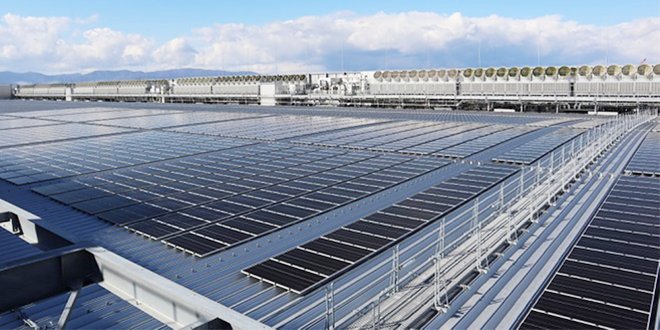
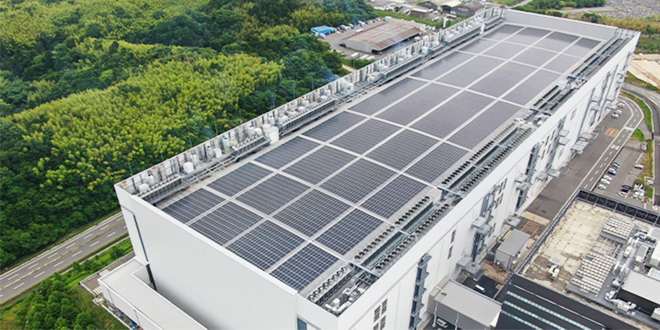
Solar power generation system at Kioxia Corporation’s Yokkaichi Plant (Fab 6)
Disclosures Aligned to the TCFD Recommendations
In June 2021, Kioxia Group announced our endorsement of the recommendations published by the Task Force on Climate-Related Financial Disclosures (TCFD).4 We believe that accurately ascertaining the climate-related impact of our business, disclosing such information to stakeholders and deepening mutual understanding are indispensable for sustainable corporate growth, and we proactively disclose that information in accordance with the TCFD recommendations.
4 A task force established by the Financial Stability Board which devises methods of disclosing climate-related financial information; an initiative to promote the disclosure of information related to climate-related risks and opportunities.
Governance and Risk Management
Kioxia Group is undertaking various activities aimed at mitigating climate change under its sustainability management structure.
At Sustainability Strategy Meetings chaired by the President and CEO, executive officers discuss our strategies and policies and check the level of achievement, while consulting with the Board of Directors on key issues. The Sustainability Committee, chaired by the Executive Officer in Charge of Sustainability, discusses and formulates key themes and sets key performance indicators (KPIs) based on the strategies and policies formulated at the Sustainability Strategy Meetings.
We have also set up Environmental Taskforce under this conference body to tackle important sustainability issues across the organization; the task force reports their areas of focus and progress to the Sustainability Committee.
In FY2022, we discussed the policy of net-zero greenhouse gas emissions and the following items based on the recommendations of the TCFD: scenario analysis, analysis of climate-related risks and opportunities, and strategies, metrics and targets.
For more information on our sustainability promotion structure, please refer to the below website.
Strategy
Scenario Analysis
Kioxia Group carried out an impact analysis of the effects of climate change on our operations by stakeholder and by business using two scenarios stipulated by the International Energy Agency (IEA) and other organizations: the 2℃ Scenario and 4℃ Scenario.5 Under the 2℃ Scenario, we believe government action, regulatory strengthening and the preferences of customers and other stakeholders will have a significant impact. For example, we assume that there will be an increase in the costs associated with the implementation of measures to reduce greenhouse gas emissions at manufacturing sites, and higher research and development costs arising from the need to develop more energy-efficient products with increased capacity. Under the 4℃ Scenario, we project rising material costs and the emergence of physical risks to our company bases.
5 The 2℃ Scenario and 4℃ Scenario are common terms applied to climate-related scenarios depicted by the IEA and other organizations. Each scenario includes specifications of the economic measures needed to suppress rising temperatures and the envisaged environmental damage in the event such increases in temperature occur.
Risks and Opportunities
Kioxia Group assesses the risks and opportunities outlined in the table below arising from the external environment in 2030, based on an analysis of potential scenarios.
We recognize the transition risks, posed by the migration to low-carbon economies, such as increased power supply costs resulting from the introduction of a carbon tax, and the cost of installing additional equipment to remove PFCs in line with increases in our manufacturing output. In addition, we recognize the potential for physical risks such as an increase in clean room air-conditioning costs resulting from a rise in outdoor temperatures.
In terms of potential opportunities arising from the transition to low-carbon economies, we envisage expanding business opportunities through the manufacture of more efficient products that use less electricity, and by reducing our own power consumption during manufacturing through the implementation of energy conservation measures.
To clarify the potential effects of climate-related risks and opportunities on our business activities, our task force conducts detailed calculations of their financial impact. Given the expansion of our business and the demand from our stakeholders for us to respond to climate change, we believe that the financial impact of both risks and opportunities in our research and development, our transactions with customers, and our electricity costs will be significant, regardless of the scenario. However, we believe that the costs of PFCs abatement equipment and of the associated renewable energy installations will have a relatively small financial impact.
We will continue to address any risks related to climate change, seeing these more as opportunities.
* Table can be scrolled horizontally.
| External events | Risks | Opportunities | ||||
|---|---|---|---|---|---|---|
| Attributes | Potential Financial Impact | Attributes | Potential Financial Impact | |||
| Introduction of carbon pricing |
(Transition Risks) Policy and Legal |
|
― | ― | ||
| Conversion to renewable energy | (Transition Risks) Technology |
|
(Transition Opportunities) Energy Sources |
|
||
| (Transition Opportunities) Resource Efficiency |
|
|||||
| Stricter promotion of energy saving measures during manufacturing | (Transition Risks) Technology |
|
||||
| Improving environmental awareness of stakeholders | (Transition Risks) Markets |
|
(Transition Opportunities) Products |
|
||
| (Transition Risks) Reputation |
|
(Transition Opportunities) Markets |
|
|||
| Transition to low carbon products | (Transition Risks) Reputation |
|
(Transition Opportunities) Markets |
|
||
| (Transition Risks) Technology |
|
|||||
| Upgrading electricity infrastructure | (Transition Risks) Technology |
|
(Transition Opportunities) Energy sources |
|
||
Extreme weather conditions |
(Physical Risks) Acute |
|
― | ― | ||
| Water shortages | (Physical Risks) Chronic |
|
― | ― | ||
| Rising temperatures | (Physical Risks) Chronic |
|
― | ― | ||

- Introduction of renewable energy
- Promotion of energy-saving activities
- Efficient use of water resources
- Development of high-capacity, high energy-consumption efficiency products
- Reinforce BCM/SCM
6 Business Continuity Management
Metrics and Targets
To help achieve net-zero greenhouse gas emissions by FY2050, Kioxia Group has established KPIs related to energy consumption, environmental impact, and the use of our products. We review the degree of achievement of these at Environmental Management Review meetings held every six months.
For example, with regard to Scope2-related energy consumption, we are promoting energy-saving activities with the stated goal of reducing the volume of emissions by 1% each year compared to the previous fiscal year. For details, please refer to “Greenhouse Gas Emissions Across our Entire Value Chain” and “Our Efforts to Adapt to Climate Change” below.
Moreover, we have set the long-term goal of using 100% renewable energy by FY2040. Through creation of an energy portfolio that incorporates energy conservation activities and the use of non-fossil certificates, we will work to secure the optimal and stable procurement of renewable energy in line with the expansion of our business. We will also work to install renewable power generation system and carbon-neural city gas in our factories.
Greenhouse Gas Emissions Across Our Entire Value Chain
Scope1, 2 and 3 CO2-equivalent greenhouse gas emissions from Kioxia Group’s business operations in FY2022 are shown in the chart below. The figures in the table below cover emissions from Kioxia Corporation, including the company’s Head Office, Yokohama Technology Campus and Yokkaichi Plant, Kioxia Iwate Corporation, and the Solid State Storage Technology Corporation (SSSTC).
(Hyphenated cells in the below list indicate “not applicable”)
Scope1 (Direct emissions)
|
CO2 Emissions in FY2022 (t-CO2) |
Category Outlines |
|---|---|
|
680,600 |
Direct emissions from in-house fuel use and our business processes |
Scope2 (Indirect emissions)
|
CO2 Emissions in FY2022 (t-CO2) |
Category Outlines |
|---|---|
|
1,899,400 |
Indirect emissions from production of electricity, heat, and steam purchased by the company |
Scope3 (Other indirect emissions not covered by Scope1 and 2)
* Table can be scrolled horizontally.
|
Category |
CO2Emissions in FY2022 |
Category Outlines |
|---|---|---|
|
1. Purchased goods and services |
3,043,200 |
Emissions from activities up to the processing of raw materials and the manufacture of parts, packaging, etc. |
|
2. Capital goods |
1,450,366 |
Emissions resulting from the construction and manufacture of our own capital goods |
|
3. Fuel- and energy-related activities not included in Scope1or 2 |
348,378 |
Upstream emissions of purchased fuels/electricity, etc. |
|
4. Upstream transport and delivery |
179 |
Emissions arising from the transportation of products and waste in Japan (excluding overseas transportation and suppliers' transportation) |
|
5. Waste generated in operations |
33,863 |
Emissions from the treatment of waste |
|
6. Business travel |
1,421 |
Emissions arising from employees’ business travel |
|
7. Employee commuting |
11,983 |
Emissions arising from employees’ commuting |
|
8. Leased assets (upstream) |
― |
― |
|
9. Downstream transportation and delivery |
― |
― |
|
10. Processing of sold products |
― |
― |
|
11. Use of sold products |
521,167 |
Emissions arising from use of sold products |
|
12. End-of-life treatment of sold products |
― |
― |
|
13. Downstream leased assets |
― |
― |
|
14. Franchises |
― |
― |
|
15. Investments |
― |
― |
|
Scope3 (Total) |
5,410,557 |
Breakdown of Scope1 direct emissions (FY2022)
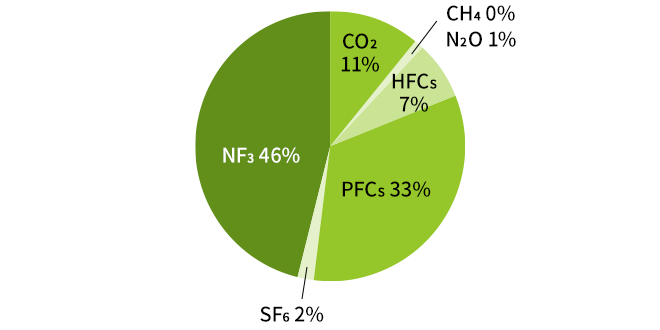
Achievements in the areas of energy consumption and greenhouse gas emissions
We plan and implement capital expenditure to secure the production capacity that will allow us to respond to the dramatic increase in the volumes of data now circulating every day. As a result, our energy consumption is on the rise.
The graph below shows Kioxia Group’s energy consumption and Scope1 and 2 greenhouse gas emissions. In order to achieve our goal of 100% renewable energy usage by FY2040 and net zero greenhouse gas emissions by FY2050, we are introducing solar power generation systems and progressing with the purchase of non-fossil fuel certificates in respect of some of the electricity we use, among other initiatives.
Volume of Energy Used (MWh)
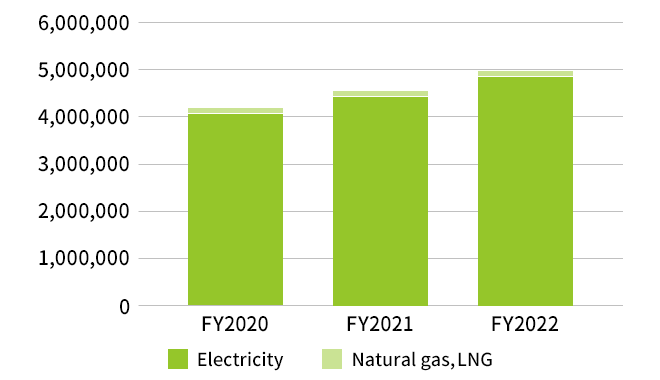
Notes:
(1) The percentage of our total energy consumption accounted for by renewable energy in FY2022 was 0.1%.
(2) Subjects are Kioxia Corporation, Kioxia Iwate Corporation and SSSTC (SSSTC results are in respect of the period from FY2021 onward).
Scope1 + Scope2 Emissions (t-CO2)
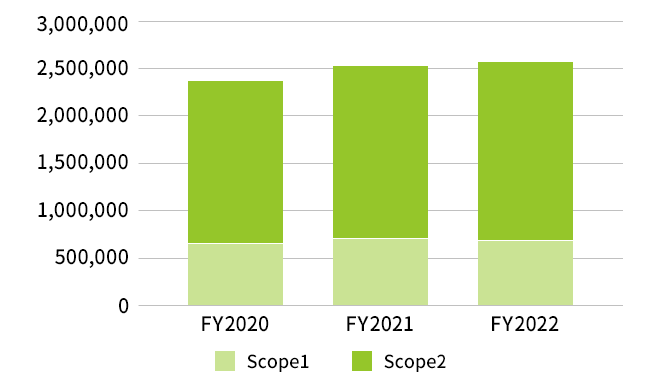
Note: Subjects are Kioxia Corporation, Kioxia Iwate Corporation and SSSTC (SSSTC results are in respect of the period from FY2021 onward).
Our Efforts to Adapt to Climate Change
Kioxia Group is progressing efforts to adapt to climate change throughout our value chain, taking into account the identified risks, opportunities and their impact.
Product Development
In the data storage market, the need for low-power consumption-type products is growing extremely rapidly, and we expect to expand sales opportunities by further developing these products. We are working on the research and development of more energy-efficient processes and increased capacity through the development of advanced integrating technology. We have set the challenging target of reducing the energy consumption of our products by 50% per 1GB from 2017 levels by FY2025.
Please see below for details.
Operation of Manufacturing Sites and Research Development Facilities
Kioxia Group has set the goal of achieving net-zero Scope1, direct emissions, and Scope2, indirect emissions resulting from its use of purchased energy.
To help achieve the reduction of Scope1 emissions, we have been proactive in the installation of abatement equipment to deal with PFCs – greenhouse gases with high global warming potential. Since FY2011, we have installed PFCs abatement equipment in 100% of the target facilities. The number of PFCs abatement equipment installed between FY2020 and FY2022 averaged more than 170 per year. Since FY2017, the total amount of CO2 reduced with PFCs abatement equipment has reached 4.24 million t-CO2.
The contribution of PFCs abatement equipment to Scope1 direct emissions reductions since FY2017 (t-CO2)
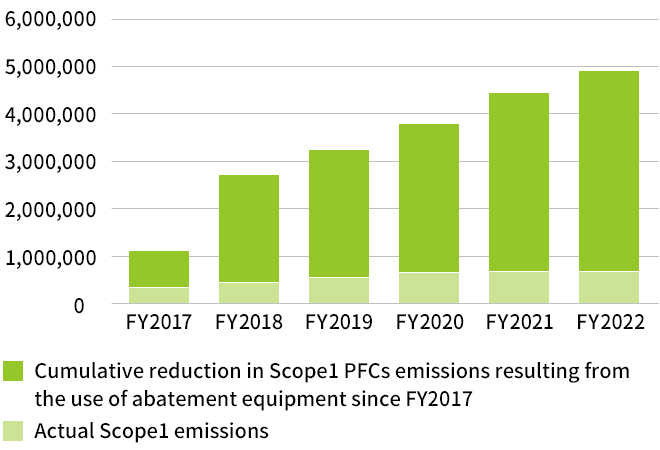
Note: Subjects are Kioxia Corporation, Kioxia Iwate Corporation and SSSTC (SSSTC results are in respect of the period from FY2021 onward).
We also conduct research and development in environmentally conscious facilities. The Flagship Building, a new research development building at the Yokohama Technology Campus that was completed in 2023, is the first building in the Group that has acquired ZEB-Ready certification.7 The other newly constructed building, the Shin-Koyasu Technology Front, features a clean room with an environmentally conscious design.
7 ZEB stands for net-Zero Energy Building. “ZEB-Ready” is one of the grades assigned by Japan’s Building Energy-efficiency Labeling System, certifying buildings that provide a comfortable indoor environment while reducing their primary energy consumption by 50% or more, excluding renewable energy.
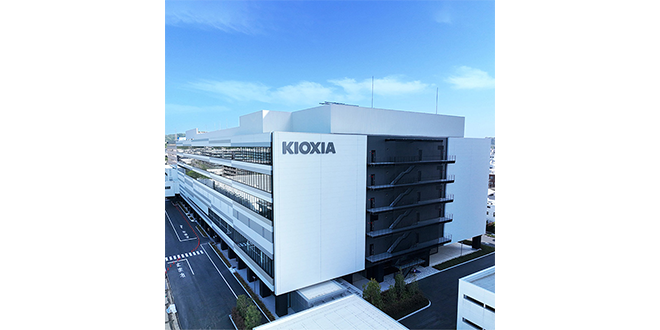
Flagship Building at Yokohama Technology Campus
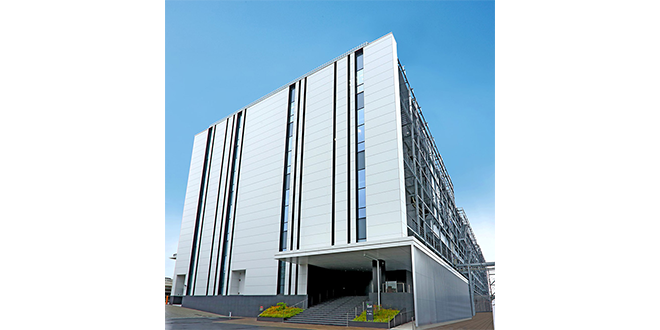
Shin-Koyasu Technology Front
We will continue to reduce the amount of Scope2 indirect emissions resulting from our use of purchased energy by making more use of renewable energy sources.
In order to optimize the efficiency of our energy consumption, Kioxia Group’s manufacturing sites have the stated goal of reducing Scope2 energy consumption by 1% compared to the previous year's total, in line with the directives contained in the Act on Rationalizing Energy Use and Shifting to Non-fossil Energy (hereinafter, “the Energy-Saving Act”) in Japan.
In FY2022 we achieved our goal of reducing energy use through various energy-saving activities, recording an actual reduction of 31,000 t-CO2 emissions per year against a target reduction of at least 25,000 t-CO2. From FY2017 to FY2022, the result of our energy conservation programs was a cumulative reduction of approximately 130,000 t-CO2 emissions.
To promote energy conservation and efficiency at each facility, we endeavor to improve and incorporate new technologies while periodically addressing priority areas and assessing the progress of improvements at meetings of our Energy Conservation Committee.
Our flash memory products are manufactured in smart factories that incorporate cutting-edge technologies such as AI and IoT. Big data collected by IoT and fully automated control facilities improve the quality and efficiency of our manufacturing processes and also help reduce their environmental impact.
Activities of Energy Conservation Committee
With the aim of further promoting energy conservation in our business activities, we have established Energy Conservation Committee at Kioxia Corporation’s Yokkaichi Plant and at Kioxia Iwate Corporation. We have also set up cross-departmental subcommittees for each target facility and manufacturing process.
At the Yokkaichi Plant, we use air conditioners in the electrical room to prevent electrical equipment there from breaking down due to high temperatures. We have reviewed these operating conditions and successfully reduced the load on the air conditioners by bringing in low-temperature outside air during the non-summer months. This initiative is expected to reduce emissions by 80 t-CO2 per year.
We also use water to maintain a constant temperature in facilities such as clean rooms and other facilities and in certain equipment. Kioxia Iwate Corporation experimented with lowering the temperature and reducing the flow rate of water used to cool manufacturing equipment. This initiative led to reduction of the load on the cooling water pumps while maintaining their cooling effect, thereby reducing overall electricity consumption and resulting in an annual reduction of 523 t-CO2 and major water savings.
Furthermore, we have reviewed test equipment and processes, which are essential for ensuring semiconductor quality; this has resulted in a reduction in the amount of test equipment used and reduced power consumption.
Value Chains
As climate change continues in the form of global warming, damage due to water-related natural disasters including typhoons and heavy rains is becoming more apparent every year. These events impact on the production of component manufacturers and on logistics, increasing the risk of disruption to our manufacturing processes and product supplies.
Kioxia Group has targeted all business units with the drafting of business continuity management (BCM) policies, and has established response protocols that take account of a variety of risks, including natural disasters.
Under our BCM policy, we strive to be fully conscious of the status of our materials and products even at times of no disruption, and ensure we have multiple suppliers. Furthermore, we are making efforts to ensure we are able to swiftly assess the situation in the event of an emergency, and to minimize effects on the business at such times by means of a collaborative process designed to ensure the early recovery of services.
Addressing climate change is also an important issue for our customers, and we closely communicate with them on the related challenges and responses. We will continue to work with our partners across the entire value chain to expand the market share of our products that consider environmental impacts and help realize a decarbonized society.
Taking Part in External Initiatives Related to Climate Change
The Kioxia Group is helping to address climate change, gathering information and making recommendations to the government through participation in industry associations and other activities.
Following the announcement by Kioxia Holdings Corporation of its endorsement of the TCFD in 2021, we are participating in the activities of the TCFD Consortium with effect from 2022. Moreover, Kioxia Corporation is involved in the addressing of energy and global warming issues as a member of the Environmental Working Group of the Japan Electronics and Information Technology Industries Association (JEITA), a group representing the electronic device industry. As a supporting member of the Japan Climate Leaders’ Partnership (JCLP) a corporate group that aims to achieve a decarbonized society, we have collaborated in measures aimed at achieving the targeted 1.5℃ reduction stipulated in the Paris Agreement, as well as in discussions about proposals to be made to the government.